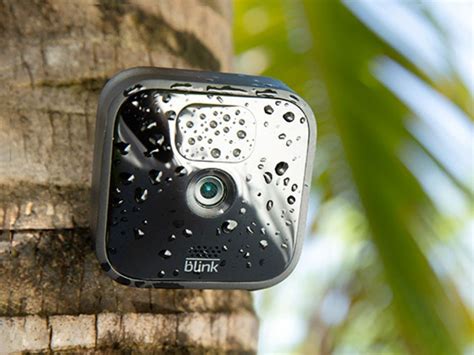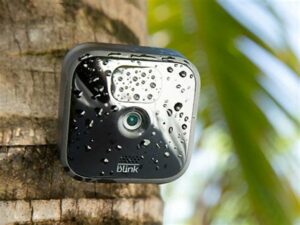
Outdoor security cameras can make a huge difference in the safety and security of your home. Each year crime is increasing with little evidence it is going to stop.
You need to provide you and your family with every tool you can to ensure continued safety and security.
An outdoor security camera is a low cost high effect way to protect not only your family but perhaps your neighborhood.
We wanted to review a couple of very good options for you when it comes to outdoor security cameras.
We are looking primarily at price, options, video quality and user reviews. We want to give you our top cameras for you further investigation.
The VisionWell CG6s outdoor camera has a 2K resolution, which is higher than the standard 1080p resolution offered by many other outdoor cameras. It also has a 150-degree wide-angle lens and supports night vision, which are both useful features for outdoor surveillance.
The camera is also weather-resistant and has a sturdy metal casing, which should help protect it from the elements and potential vandalism. Additionally, the camera offers motion detection with adjustable sensitivity levels and can send notifications to your phone when motion is detected.
The Blink Outdoor 3rd Gen outdoor camera has a 1080p resolution, a 110-degree field of view, and supports night vision, which are standard features for most outdoor security cameras. The camera is weather-resistant and has a two-year battery life, which is longer than many other outdoor cameras that require frequent battery changes.
The camera also offers motion detection with customizable activity zones, and it can send push notifications to your smartphone when motion is detected. The Blink Outdoor 3rd Gen camera can be integrated with Amazon Alexa, which allows you to view live streams or playback recorded clips through your Alexa device.
The GMK security camera is a less expensive option (it was on sale when we reviewed), which is one reason we included it.
It has 1080p resolution, live video and night night vision. Rechargeable battery, motion detection and cell phone notifications. Overall it has many of the same features as the Blink camera above.
When considering outdoor security cameras, there are several options and features to look for, depending on your specific needs and preferences. Here are some of the key options to consider:
- Resolution: Look for cameras with high-resolution video, such as 1080p or 4K, to ensure clear footage.
- Field of view: Choose cameras with a wide-angle lens or a pan-and-tilt feature to cover a larger area.
- Night vision: Ensure that the camera has night vision capabilities to capture clear footage in low-light conditions.
- Motion detection: Look for cameras with motion detection features that can trigger alerts and recordings when motion is detected.
- Two-way audio: Consider cameras with two-way audio so that you can communicate with visitors or potential intruders.
- Weather resistance: Choose cameras that are weather-resistant and can withstand extreme temperatures and harsh weather conditions.
- Storage: Decide whether you want your footage to be stored locally on the camera or in the cloud.
- Power source: Consider whether you want a camera that is battery-powered or needs to be plugged in.
- Integration with other smart devices: Look for cameras that can integrate with other smart home devices, such as smart speakers or doorbells.
- Cost: Finally, consider the cost of the camera and any ongoing subscription fees for cloud storage or additional features.
There are several benefits of using outdoor cameras. Some of them are:
- Deterrence: Outdoor cameras act as a visible deterrent to potential intruders and can prevent break-ins and other crimes.
- Increased sense of security: Knowing that outdoor cameras are monitoring your property can give you peace of mind and increase your sense of security.
- Evidence: Outdoor cameras can provide valuable evidence in case of a crime, such as identifying a suspect or capturing footage of the crime itself.
- Remote monitoring: Many outdoor cameras come with remote monitoring features that allow you to check on your property from anywhere, at any time, using a smartphone or computer.
- Cost-effective: Outdoor cameras are a cost-effective security solution compared to other security measures like hiring security guards or installing a full-fledged security system.
- Insurance benefits: Some insurance companies offer discounts on homeowners insurance premiums if you have outdoor cameras installed, as they can reduce the risk of property damage or theft.
- Monitor activities: Outdoor cameras can be used to monitor outdoor activities, such as children playing, pets, and delivery personnel.
Outdoor cameras are an effective and convenient way to increase security, provide evidence, and give peace of mind to homeowners and business owners.
Outdoor security cameras can help deter crime and prevent criminal activity. The presence of visible cameras can act as a deterrent for potential intruders, as they are less likely to target a property that has security measures in place. Additionally, if a crime does occur, the footage captured by outdoor security cameras can provide valuable evidence for law enforcement and aid in identifying suspects.
However, it’s important to note that outdoor security cameras are not foolproof and may not prevent all criminal activity. Some intruders may be undeterred by the presence of cameras or may take steps to avoid detection, such as wearing masks or disguising their appearance.
Overall, while outdoor security cameras may not guarantee complete protection against crime, they can be a useful tool in deterring criminal activity and providing valuable evidence in the event of a crime. It’s important to use them in conjunction with other security measures, such as proper lighting and secure locks, to create a comprehensive security plan.
When using outdoor cameras, there are several legal considerations that should be taken into account:
- Privacy laws: Depending on the country or state, there may be privacy laws that regulate the use of outdoor cameras. For example, in some jurisdictions, it may be illegal to record audio without consent, or to record areas where there is an expectation of privacy, such as a neighbor’s backyard or a public bathroom.
- Notification: It is generally recommended to notify people that outdoor cameras are in use, either by posting signs or informing neighbors. This helps to avoid misunderstandings and can deter potential intruders.
- Prohibited areas: There may be certain areas where it is prohibited to install outdoor cameras, such as government buildings, schools, or hospitals. It is important to check local regulations to ensure compliance.
- Data protection: If the outdoor cameras are recording footage, it is important to ensure that the data is stored securely and is not accessible by unauthorized parties. It may also be necessary to obtain consent from individuals whose images are captured in the footage.
- Use of footage: The use of footage from outdoor cameras should be limited to the intended purpose, such as for security or surveillance. It should not be used for any other purposes, such as harassment or discrimination.
It is important to be aware of the legal considerations when using outdoor cameras and to ensure that they are used in compliance with local regulations and privacy laws.
 Siren Alarm WiFi Surveillance Indoor Home Camera, Color Night Vision, 2-Way Talk, Waterproof, Cloud/SD Storage
Siren Alarm WiFi Surveillance Indoor Home Camera, Color Night Vision, 2-Way Talk, Waterproof, Cloud/SD Storage
 life, motion detection, set up in minutes – 3 camera system
life, motion detection, set up in minutes – 3 camera system Talk Battery Powered WiFi Home Indoor Camera IP65 Weatherproof Spotlight Siren Alarm Cloud/SD Storage
Talk Battery Powered WiFi Home Indoor Camera IP65 Weatherproof Spotlight Siren Alarm Cloud/SD Storage